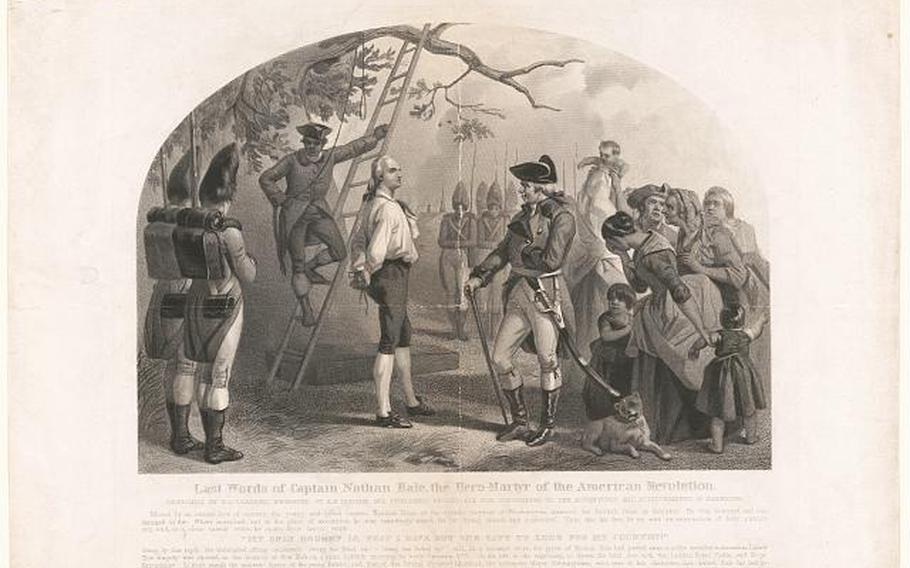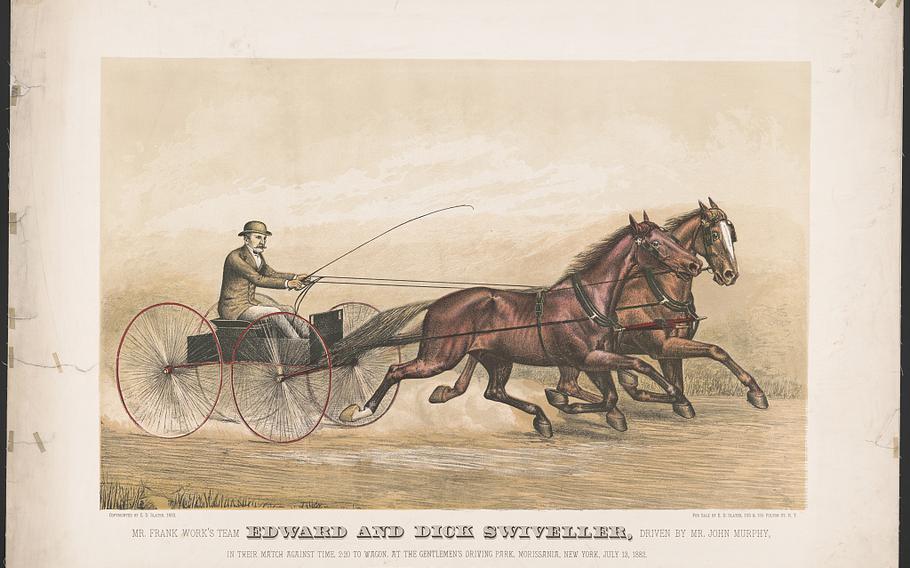
A print depicting the execution of Nathan Hale. (Alexander Hay Ritchie/Library of Congress)
As King Charles III prepares for his coronation, the heir to the throne has substantial American blood for the first time in history — with a connection to the Revolution.
Prince William is one-sixteenth American through his mother, the late Princess Diana, records show, and his lineage traces back to Benajah Strong, who was battling English troops when the first shots were fired in 1775.
That means May 6, when William will play a central role at Westminster Abbey, taking an oath of fealty to his father, will mark a family’s unlikely turn from fighting the monarchy to preparing to assume control of it.
“This speaks to the bond between Great Britain and America, as the American Revolution was more like the American Civil War in the 1860s, with many on both sides knowing each other,” said Joseph Stoltz, the library director at the Society of the Cincinnati, a hereditary group dedicated to the Revolutionary War.
The first Strong ancestor immigrated from England to New England in 1635, and Benajah Strong, William’s sixth-great-grandfather, was born in 1740 in Coventry, Conn. He signed on as a private in the Connecticut militia.
Since the Boston Tea Party of 1773, New England had been under the surveillance of British regulars, dispatched to quell uprisings and root out rebels who had been recruiting men and forming militias. In April 1775, British troops moved from Boston toward Lexington and Concord, to seize the colonists’ military supplies and arrest revolutionaries like Samuel Adams and John Hancock.
But the rebels mounted a formidable defense at both sites, aided by the “rapid-reaction force” of minutemen like Strong, who helped spread the word of a British expedition and save valuable assets, Stoltz said. Strong was known as a “Lexington Responder,” said John Holmy, Coventry’s municipal historian, who said he was unaware of Coventry’s connection to the Prince of Wales.
Those opening skirmishes signaled this would not be the easy victory King George III had anticipated. The American War of Independence was underway.
“It is ironic that William’s ancestor kicked off the fight against Crown forces,” Stoltz said.

Frank Work, Prince William’s great-great-great grandfather, built a $100,000 stable in Manhattan, and his horses became celebrated. (Library of Congress)
Another William relative, Strong’s Yale-educated nephew Nathan Hale, had been working as a teacher in New London, Conn., when the war started. Like his uncle, Hale joined the Connecticut militia and quickly rose through the ranks. By the summer of 1776, Hale had been recruited to Knowlton’s Rangers, the first known U.S. Army intelligence unit, under the leadership of Col. Thomas Knowlton, according to Anne Marie Charland, an administrator at the Nathan Hale Homestead, which oversees the Hale family property in Coventry.
At the time, the British were inching closer to a Manhattan invasion, and Gen. George Washington was desperate to infiltrate their ranks to determine their next moves. Hale was the first to raise his hand. In September 1776, he went to British-occupied Long Island to spy, with the cover of an unemployed Dutch schoolteacher. Some historians believe his fatal mistake was carrying his Yale diploma with him. Later that month, when the Great Fire of New York ravaged the city, British troops rounded up hundreds of patriots for interrogation, and Hale was stopped in nearby Queens.
The British general William Howe grilled Hale at his military headquarters. On Sept. 22, 1776, two months after the Declaration of Independence, Hale was hanged at the age of 21, becoming the first spy for America to be executed, Charland said. His body was left hanging for days, as a gruesome reminder to those who dared defy the crown, but his possibly apocryphal final words — “I only regret that I have but one life to lose for my country” — lived on.
“He knew he might get hanged. He was a true believer,” Stoltz said.
Many monuments have been erected in Hale’s honor, including one in the U.S. Capitol’s Statuary Hall Collection. Hale’s body was never recovered, but in Coventry, an obelisk stands in the Nathan Hale Cemetery where members of his family are buried. In its shadow is the nondescript, weatherworn grave of his Uncle Benajah, a stark contrast to the grand resting place at Windsor Castle that awaits his royal descendant. Strong’s tombstone calls him “food for worms.”
Strong’s son, Joseph Strong, became a leading physician in Philadelphia in the late 18th and early 19th centuries, receiving a patent for his invention of a substance that can control bleeding during surgery. Eventually, William’s American ancestors ended up in Chillicothe, Ohio, where his great-great-great grandfather Frank Work became the ultimate American success story, according to Pat Medert, the archivist and historian at the Ross County Historical Society, which has tracked the royal family’s connection to its area.
Work, born in 1819 and raised by a single mother as the youngest of five children, showed a rebellious streak from a young age — scandalizing Chillicothe by riding a horse, quite unroyally, nude through the streets. He ran away from the Midwest at 15, established a prosperous dry goods business in New York and by 1874 had bought a seat on the New York Stock Exchange, Medert said.
Work soon entered the orbit of the 19th-century business titan Cornelius Vanderbilt, and the two men bonded over their love of all things equine. Work became so wealthy that in addition to his considerable real estate, he built a luxurious stable in Manhattan that was worth $100,000 at the time. When he died in 1911, he was a multimillionaire many times over.
His daughter and namesake, William’s great-great-grandmother Frances, kept it up, achieving the Gilded Age honor of inclusion on Mrs. Astor’s “Four Hundred,” a list of New York’s most promising socialites. Presciently, Frances came to be known as “Princess Fannie,” for her regality and charm.
She married James Boothby Burke Roche in 1880, a decision that outraged her father, who, correctly, believed Roche was just another British aristocrat who was after an American heiress’s money.
“I am American to my backbone,” Frank Work was reported to have said. “Therefore, I have only contempt for these helpless, hopeless, lifeless men that cross the ocean to carry off the very flower of our womanhood.”
Yet in 1961, across that ocean, Fannie Work’s great-granddaughter Diana Frances Spencer would be born on the royal family’s Sandringham estate. And, through her marriage to Charles, an American family with patriot roots would find its blood mingled with the British crown.